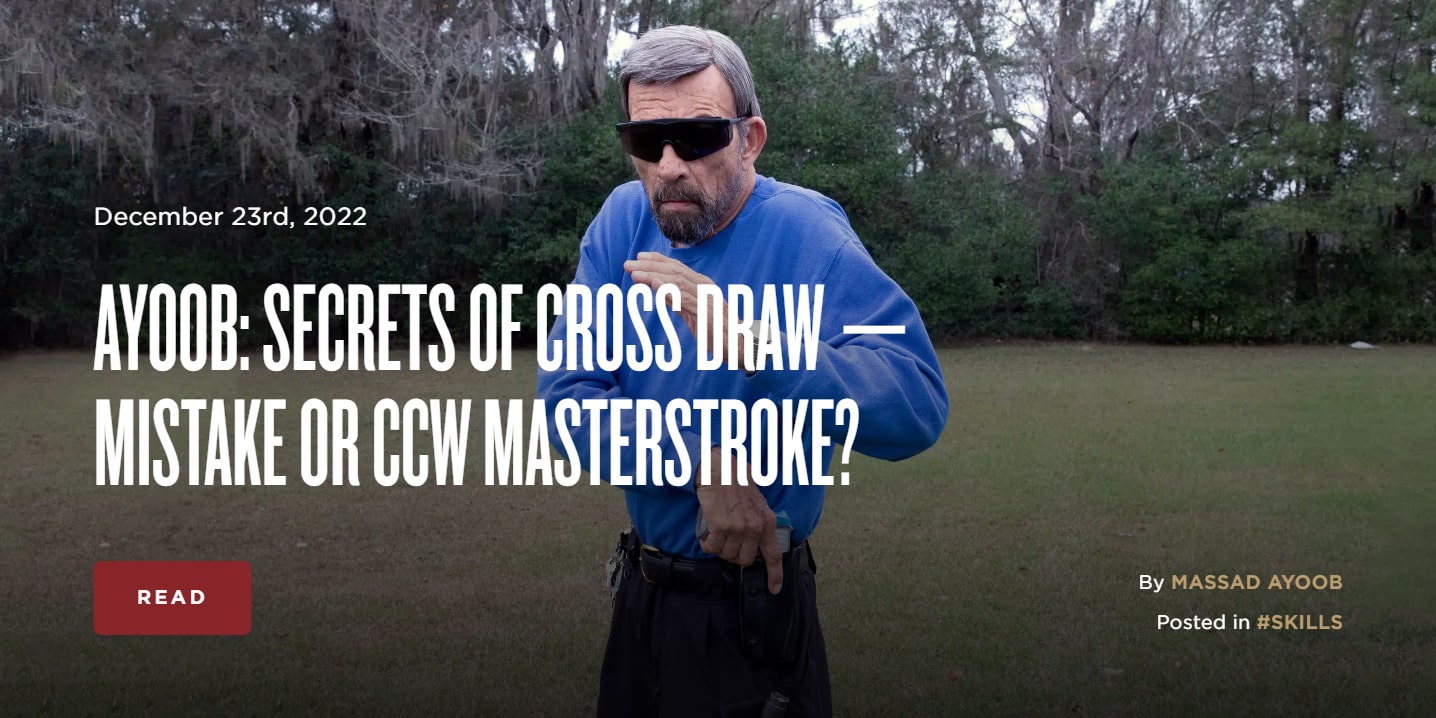Hello all, here is today's article posted on TheArmoryLife.com. It is titled “Ayoob: Secrets of Cross Draw — Mistake or CCW Masterstroke?” and can be found at https://www.thearmorylife.com/ayoob-secrets-of-cross-draw/.



Try Falco. I have had several holsters made with neutral cants. Falco will make whatever cant you desire and for many guns with different sights.Thank you for this article. Much appreciated. I am 78 with a deteriorating right shoulder socket making standard strong side draw very painful and, in fact, almost impossible. Therefore, when I began concealed carrying, I found myself having to carry on the weak-side, butt forward so I could cross draw. However finding a holster from ANY manufacturer for my EDC weapon (a Taurus G3C with under-barrel laser) with any amount of negative cant so the butt was angled forward at the right degree turned out to be impossible. Fortunately, Viridian Weapon Tech stepped up and modified a UM Tactical holster for me ... at no extra cost, I might add! Great customer service on their part! They've gained a faithful customer for future purchases. But the entire experience of finding a suitable crossdraw holster made me think I was some kind of oddball. Your article has done two things for me. First it has shown me I am not alone. And second it has taught me better (proper?) placement of my weak side support arm while drawing. Thank you.
Thank you!Try Falco. I have had several holsters made with neutral cants. Falco will make whatever cant you desire and for many guns with different sights.
I was trained, as most of us were I think, using the Weaver Stance for using a pistol. Some time prior to the John Wick movies I was introduced to the CAR (Center Axis Relock) shooting method as a better, more intuitive deployment an employment means from the Cross Draw position. I found that the CAR works very well, especially if one is carting a large or full frame platform.Great article, I enjoyed this one. My daily CW is carried in the cross draw appendix IWB position, with my spare IWB mag carriers on my strong side where they're easy to access with my support hand. For me, this is a very fast position to access and get my weapon into action. Most importantly, it keeps my firearm in front of me, where someone behind me would have a difficult time snatching it. I practice drawing from different angles and stance limitations, different clothing, various distance and speed factors, etc. to try to be proficient regardless of the scenario, and appendix cross draw seems to check all the boxes for me. Doc Holliday did all right with it, too, so who can argue with Doc?I do recommend training with an angled stance when drawing and presenting from this carry position, though. I shoot right-handed, and whenever possible will have my right foot back and my hips angled approx. 45 degrees off the centerline to my target. This lets the muzzle clear the holster already rising on that centerline. Once clear, the support hand releases the concealing clothing and take its place on the weapon as it's coming up. It's surprisingly efficient.
I think for the most part CAR is just something people do to look cool. Are there advantages, sure, but there are also disadvantages. I am familiar enough with it to do it consistently because it's something I worked on when I first figured out I was cross eye dominant and was developing my technique for dealing with that.I was trained, as most of us were I think, using the Weaver Stance for using a pistol. Some time prior to the John Wick movies I was introduced to the CAR (Center Axis Relock) shooting method as a better, more intuitive deployment an employment means from the Cross Draw position. I found that the CAR works very well, especially if one is carting a large or full frame platform.
For me it is a smoother transition from holster to target acquisition with, what seems to me, a natural and intuitive movement.
Also, the CAR method puts the users body position in the smallest profile aspect to the target without giving it any thought.
I practice this several times a week and of course it may be done as a dry fire exercise. I would also suggest a basic course in its fundamentals if interested. Strive to as high a degree of competency, comfort coupled with target acquisition as one may be able to attain. For about 99% of us this will be more than sufficient for CD EDC. The John W. / Hollywood / level is really not the goal nor attainable to most of us! However, the CAR system is a viable method to consider.
I don’t, an didn’t mean to suggest that CAR was/is a be all end all position. I’m sorry if that’s how my comment came across. It was meant only as an observation from my own expierance with cross draw carry as a viable means of access and effective deployment. I find it comfortable and effective, useful in confined spaces and CQC. And very compatible with the Cross Draw (belt, shoulder or chest holster) carry option in relation to deploying that weapon.I think for the most part CAR is just something people do to look cool. Are there advantages, sure, but there are also disadvantages. I am familiar enough with it to do it consistently because it's something I worked on when I first figured out I was cross eye dominant and was developing my technique for dealing with that.
It's definitely not something I would whip out unless I was clearing a house or something though. Even then I am more likely to use SUL.
